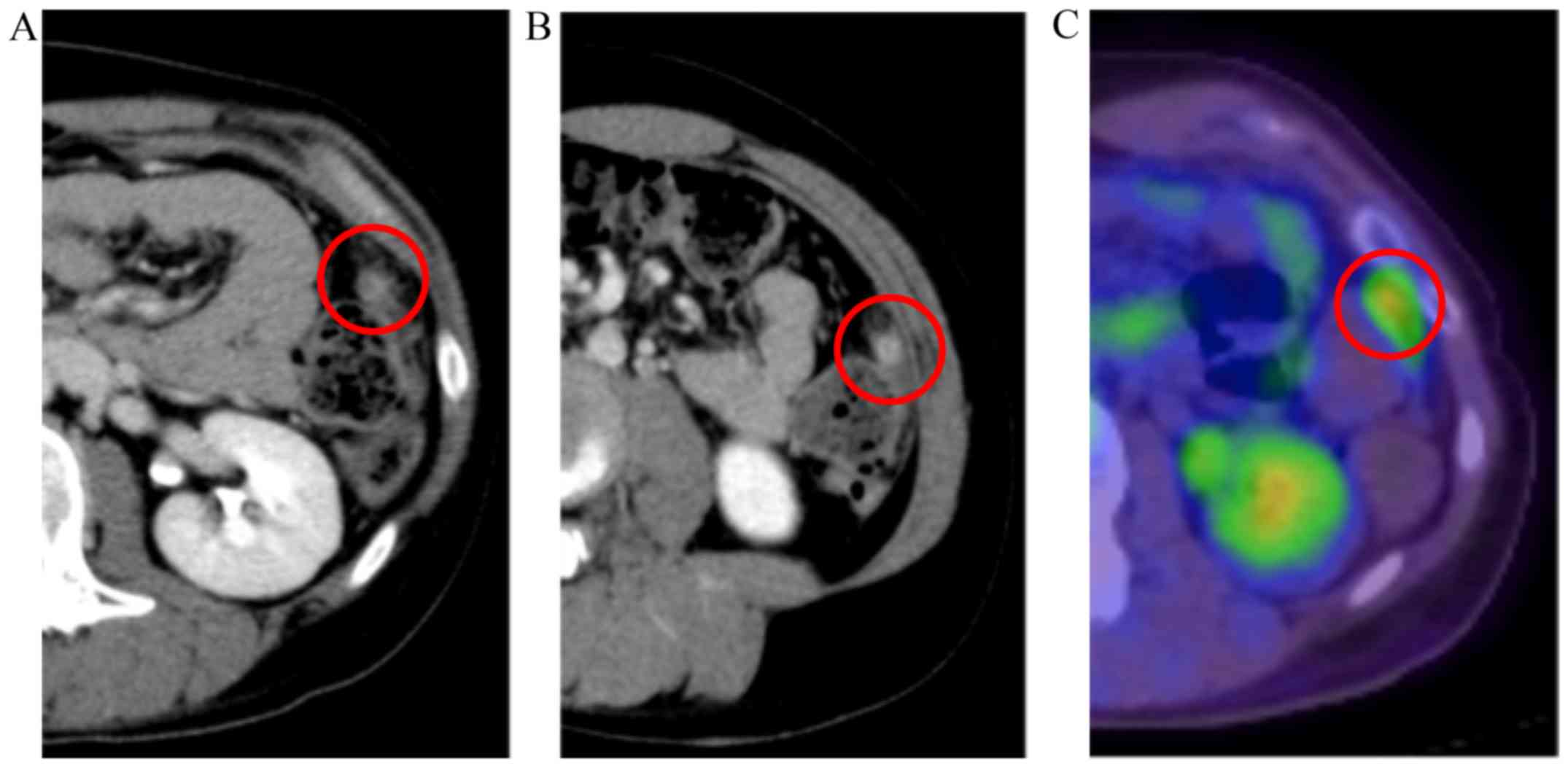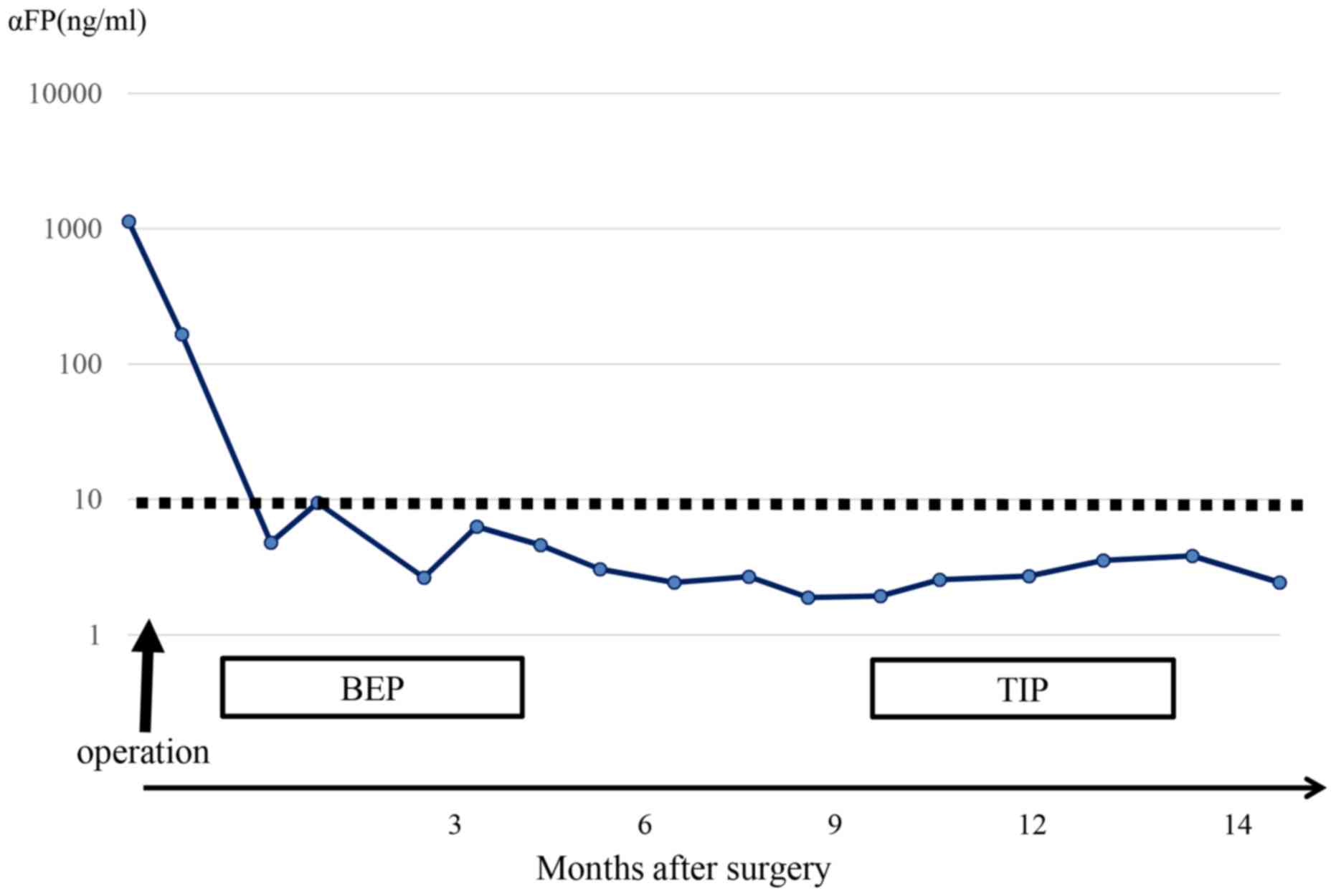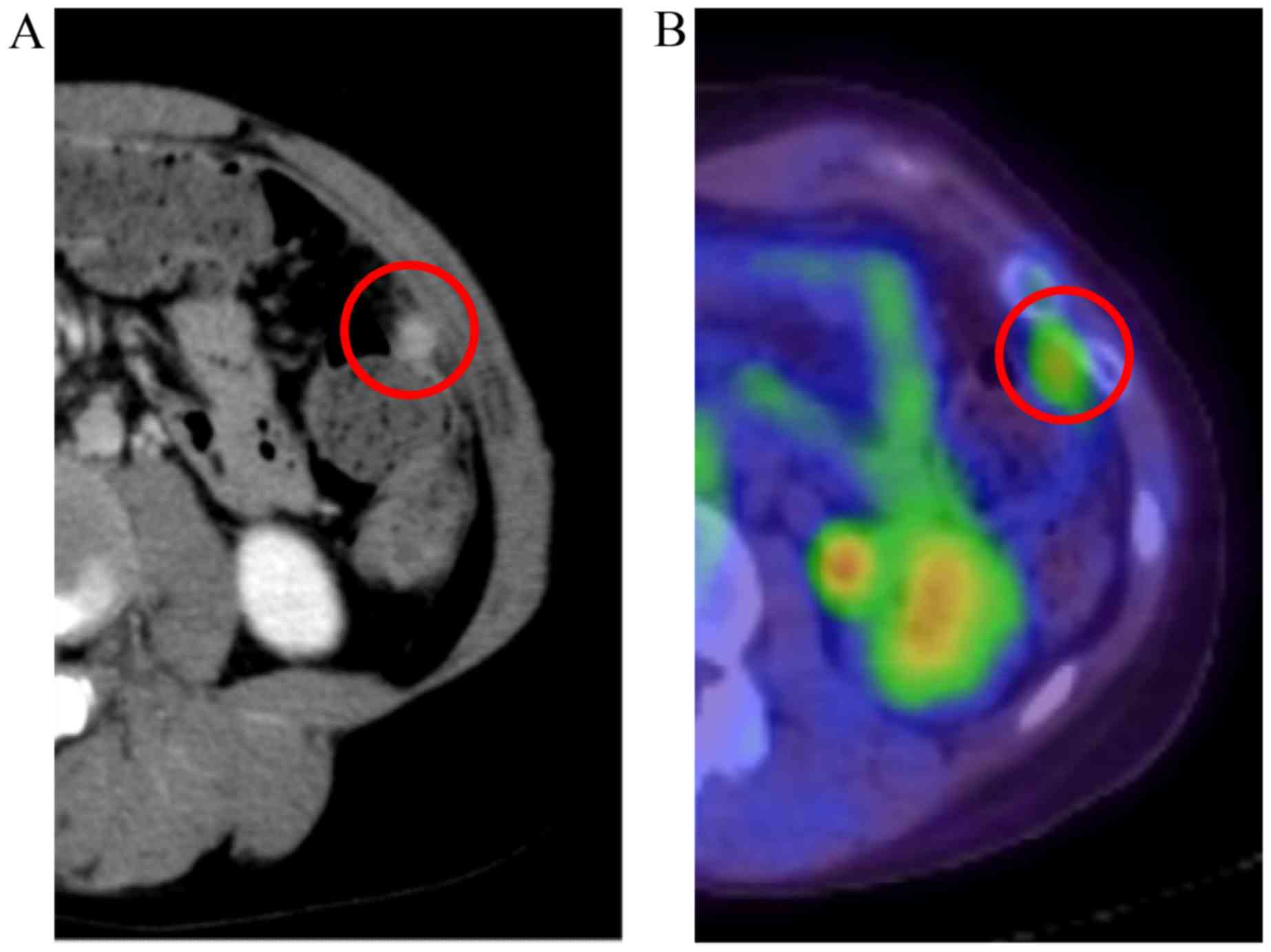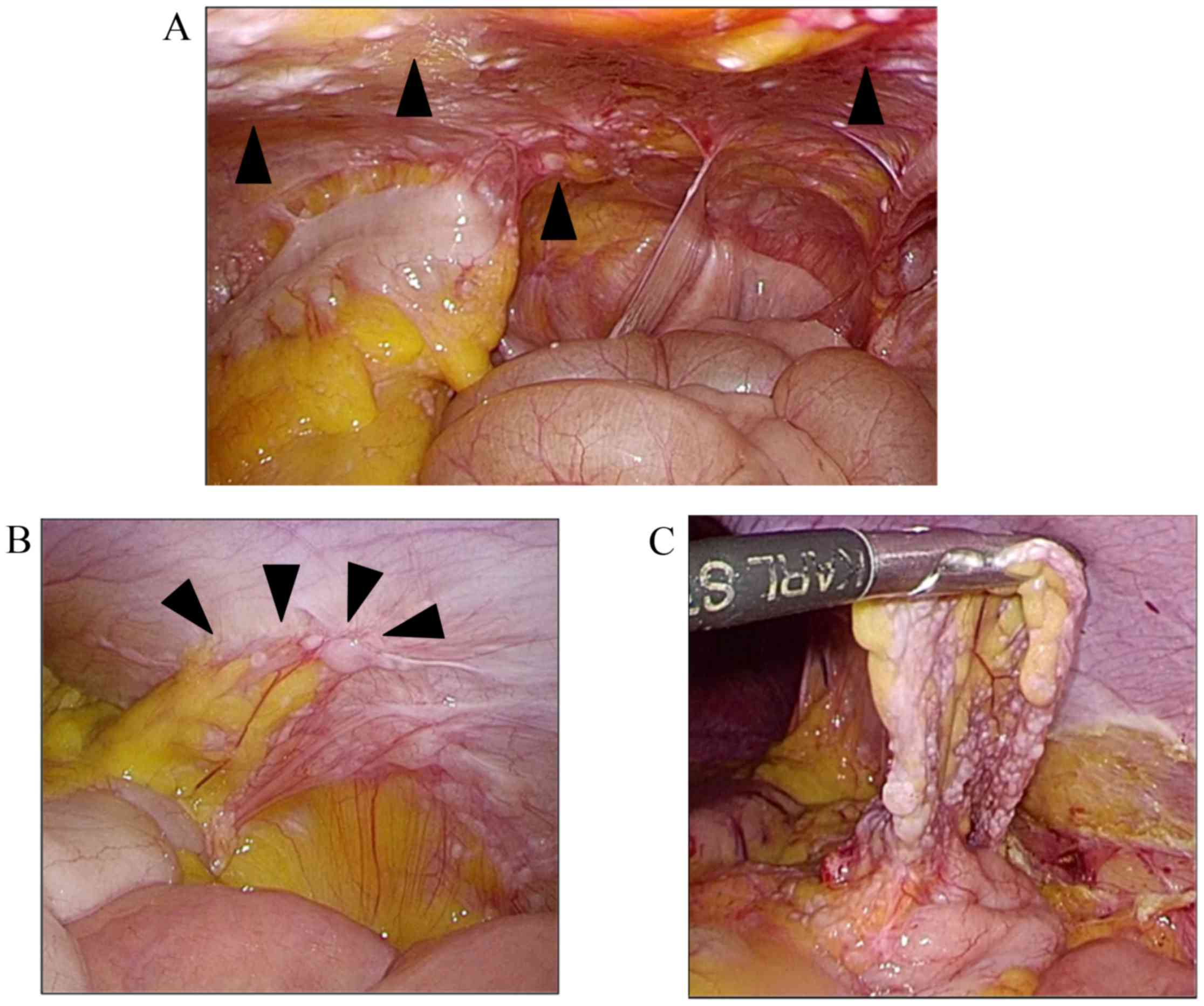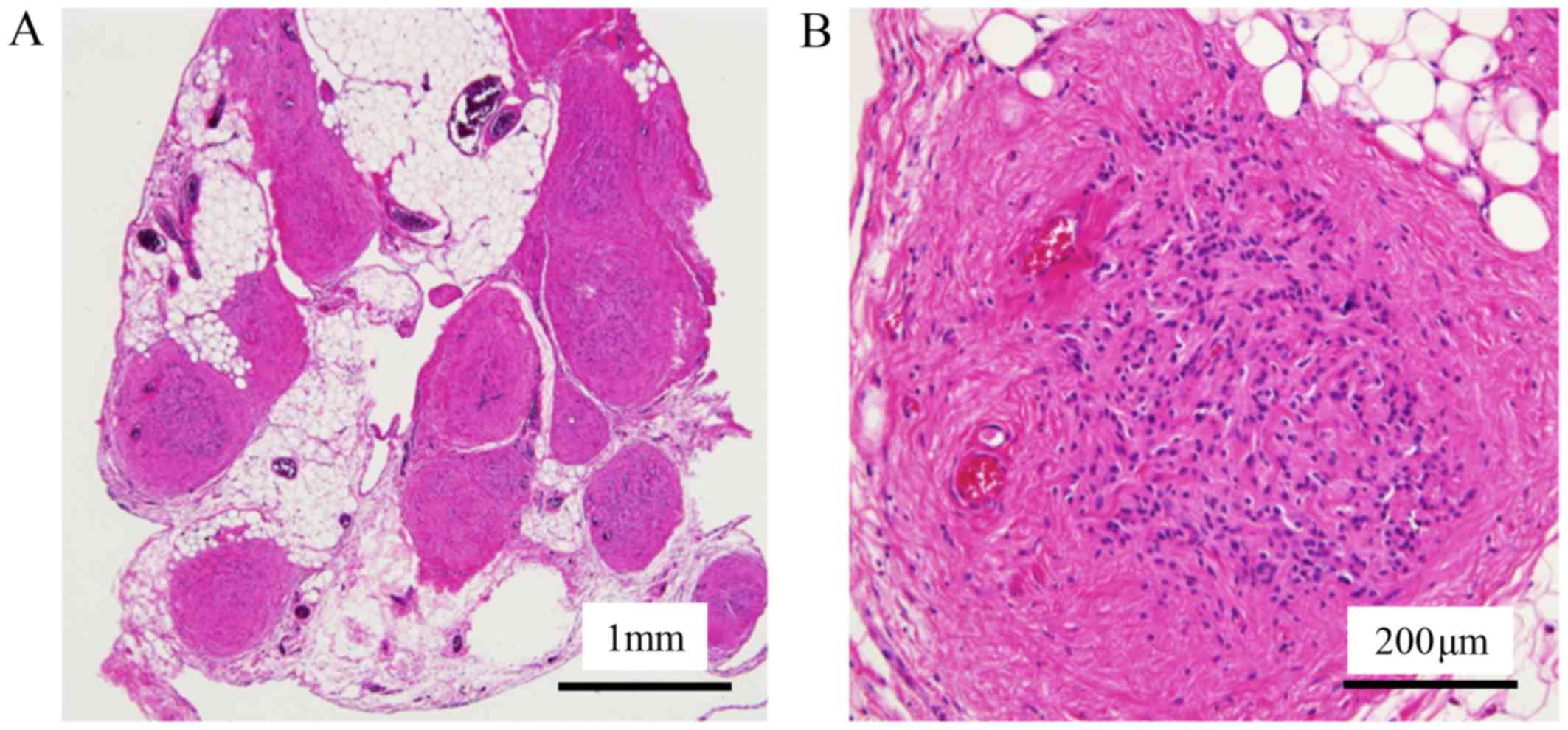Gliomatosis peritonei with 18F-fluorodeoxyglucose accumulation and contrast enhancement secondary to immature teratoma: A case report
- Authors:
- Published online on: May 2, 2018 https://doi.org/10.3892/mco.2018.1618
- Pages: 40-43
Abstract
Introduction
Immature teratoma (IM) is a germ cell tumor that develops in the ovary of the relatively young women (1). Chemotherapy involving cisplatin, etoposide and bleomycin (BEP) has improved its prognosis, but recurrence of IM is occasionally encountered (2–4). Thus, it is important to assess for recurrence in the follow-up examination. In addition to IM recurrence, gliomatosis peritonitis (GP) and growing teratoma syndrome (GTS) can develop after treatment for IM (5–7).
GP is characterized by mature glial tissue in the peritoneum, and GTS is defined as an increase in tumor size, which is composed of only a mature teratoma, after treatment for IM. Both are histologically benign tumors. In some cases, a tumor becomes large and requires resection. However, when symptoms are not present, we do not have to resect the tumor does not require resection (5–7). On the other hand, we start treatment as soon as possible in cases involving the recurrence of IM.
Thus, it is very important to distinguish whether the tumor represents IM recurrence or the development of GP and GTS.
Imaging examination, such as computed tomography (CT) and fluorodeoxyglucose positron emission tomography (FDG-PET), is widely used clinically. Given that these techniques can be used to visualize vascularization and glucose transport, which are characteristics of malignant cells, they are useful (8–10).
Here, we report on a tumor that developed after treatment for IM and exhibited both the contrast enhancement and accumulation of FDG. Diagnostic laparoscopy was useful to obtain an accurate diagnosis. The patient is now undergoing regular follow-up without any evidence of IM recurrence.
Case report
A 30-year-old nulliparous woman presented with abdominal discomfort. MR image suggested malignant ovarian cancer (Fig. 1A), and a total abdominal hysterectomy, and bilateral salpingo-oophorectomy and partial omentectomy were performed. She was diagnosed with a grade 2 immature teratoma (Fig. 1B and C), and the FIGO stage was IIIB (pT3bNXM0). Four cycles of BEP chemotherapy were administered after surgery. α-feto protein (AFP), which was markedly elevated before treatment, decreased rapidly. At the end of treatment, a CT test was performed, and we did not find any evidence of tumor recurrence (Fig. 2A).
Six months after initial treatment, follow-up CT was performed. A tumor with contrast enhancement developed on the splenic flexure (Fig. 2B). To distinguish whether the tumor was a recurrence of IM or GP and GTS, a PET/CT test was performed. As a result, accumulation of FDG was noted in the same place (SUVmax, 3.43) (Fig. 2C). AFP levels remained normal (Fig. 3).
At that time, no reports were available that referred to GP and GTS with FDG accumulation. Although low levels of AFP are atypical of recurrence of IM, we thought that the tumor represented recurrent IM. Upon patient consent, four cycles of paclitaxel, ifomide and cisplatin (TIP) chemotherapy were administered.
However, contrast enhancement of the tumor remained after TIP treatment (Fig. 4A). FDG accumulation also remained (SUVmax, 3.15) (Fig. 4B). AFP levels remained normal (Fig. 3).
Surgery can be indicated for local and chemorefractory recurrent IM. Although there was no report that referred to GP and GTS with FDG accumulation at that time, we proposed the possibility of GP and GTS with FDG accumulation. Upon obtaining patient consent, diagnostic laparoscopy was performed to make an accurate diagnosis.
With the help of digestive surgery doctors, diagnostic laparoscopy was performed. Numerous white nodes were located in the peritoneum (Fig. 5A). A tumor on the splenic flexure adhered to the peritoneum wall surrounded by omentum (Fig. 5B).
Under laparoscopy, the adhesion was removed carefully, and the tumor was resected (Fig. 5C). We also resected several white perinoneal nodes. Intraoperative rapid diagnosis revealed GP, and no evidence of IM was found. Detailed pathological examination revealed mature glioma and fibrosis in the tumor (Fig. 6). The tumor was diagnosed as GP.
At the one-year follow-up examination after diagnostic laparoscopy, we did not find any evidence of IM recurrence. The patient is currently undergoing regular follow-up.
Discussion
In this report, we describe a case of GP with both contrast enhancement and FDG accumulation, which developed after treatment for IM. As a result, the tumor was GP not recurrent IM. To date, only one report describes GP with FDG accumulation developed after treatment for IM (11). However, to our knowledge, this is the first report that describes GP with both FDG accumulation and contrast enhancement.
In the follow-up of malignancies, imaging tests play an important role. Vascularization and facilitated glucose transport are characteristics of malignant tumor. Given that enhanced CT can evaluate tumor vascularization, FDG-PET can evaluate glucose transport. These tests represent useful imaging tests to evaluate tumor function.
In this case, the tumor harbored both contrast enhancement and FDG accumulation. Thus, we initially assumed IM recurrence and administered 2nd line chemotherapy. However, the 2nd line chemotherapy TIP did not alter contrast enhancement, FDG accumulation or tumor size.
Given that tumor status and levels of the tumor marker AFP remained stable, we assumed GP and GTS, which are known to develop in relation to IM.
Occasionally, GP or GTS become large and must be resected if symptoms develop. However, these lesions are pathologically benign tumors. We believe that glucose transport should be reduced in GP compared with malignant tumors. However, recently, a case of GP with high FDG uptake was reported. Although a detailed mechanism must be elucidated, glia that consist of GP may occasionally exhibit increased glucose transport regardless of the degree of malignancies.
When we cannot make an accurate diagnosis based on imaging tests, pathological examination is very important. In this case, we could make an accurate diagnosis by diagnostic laparoscopy. As laparoscopic surgery becomes popular, it is useful in the field of gynecologic malignancies. Compared with laparotomy, laparoscopic surgery reduces intraoperative blood loss, post-operative pain, and the length of hospital stay. This technique also offers a more speedy recovery. In addition, we obtain a wide intra-abdominal view with a smaller incision. If an accurate diagnosis is difficult to obtain, close observation and biopsy of the lesion with laparoscopy can be considered.
In conclusion, we report a case of GP with both contrast enhancement and high FDG uptake that developed after treatment for IM. We could not distinguish GP or GTP from IM recurrence by imaging tests. Biopsy and pathological examination of the lesion by laparoscopic surgery were useful. In the follow-up examination after treatment for IM, we should consider that GP, which cannot be completely distinguished from IM recurrence by imaging tests alone, can develop. In such a case, we should consider diagnostic laparoscopy to obtain an accurate diagnosis.
Acknowledgements
Not applicable.
Funding
No funding was received.
Availability of data and materials
All data has been presented in this published study.
Authors' contributions
OT performed treatments and wrote the manuscript; YK performed treatments and edited the manuscript; IY, OJ, SM, SH, HT, YK and SK performed treatments.
Ethics approval and consent to participate
Written informed consent was obtained from the patient in the present study.
Consent for publication
Not applicable.
Competing interests
The authors declare that they have no competing interests.
References
|
Zalel Y, Piura B, Elchalal U, Czernobilsky B, Antebi S and Dgani R: Diagnosis and management of malignant germ cell ovarian tumors in young females. Int J Gynaecol Obstet. 55:1–10. 1996. View Article : Google Scholar : PubMed/NCBI | |
|
Williams S, Blessing JA, Liao SY, Ball H and Hanjani P: Adjuvant therapy of ovarian germ cell tumors with cisplatin, etoposide and bleomycin: A trial of the Gynecologic Oncology Group. J Clin Oncol. 12:701–706. 1994. View Article : Google Scholar : PubMed/NCBI | |
|
Norris HJ, Zirkin HJ and Benson WL: Immature (malignant) teratoma of the ovary: A clinical and pathologic study of 58 cases. Cancer. 37:2359–2372. 1976. View Article : Google Scholar : PubMed/NCBI | |
|
Mangili G, Scarfone G, Gadducci A, Sigismondi C, Ferrandina G, Scibilia G, Vigano R, Tateo S, Villa A and Lorusso D: Is adjuvant chemotherapy indicated in stage I pure immature ovarian teratoma (IT)? Amulticentre Italian trial in ovarian cancer (MITO-9). Gynecol Oncol. 119:48–52. 2010. View Article : Google Scholar : PubMed/NCBI | |
|
André F, Fizazi K, Culine S, Droz J, Taupin P, Lhommé C, Terrier-Lacombe M and Théodore C: The growing teratoma syndrome: Results of therapy and long-term follow-up of 33 patients. Eur J Cancer. 36:1389–1394. 2000. View Article : Google Scholar : PubMed/NCBI | |
|
Fortt RW and Mathie IK: Gliomatosis peritonei caused by ovarian teratoma. J Clin Pathol. 22:348–353. 1969. View Article : Google Scholar : PubMed/NCBI | |
|
Yoon NR, Lee JW, Kim BG, Bae DS, Sohn I, Sung CO and Song SY: Gliomatosis pertonei is associated with frequent recurrence, but does not affect overall survival in patients with ovarian immature teratoma. Vichows Arch. 461:299–304. 2012. View Article : Google Scholar | |
|
Gu P, Pan LL, Wu SQ, Sun L and Huang G: CA125, PET alone, PET-CT, CT and MRI in diagnosing reccurent ovarian carcinoma: A systematic review and meta-analysis. Eur J Radiol. 71:164–174. 2009. View Article : Google Scholar : PubMed/NCBI | |
|
Beyer T, Townsend DW, Brun T, Kinahan PE, Charron M, Roddy R, Jerin J, Young J, Byars L and Nutt R: A combined PET/CT scanner for clinical oncology. J Nucl Med. 41:1369–1379. 2000.PubMed/NCBI | |
|
Oldan JD and Patel PS: Positron emission tomography/computed tomography for gynecologic malignancies. Obstet Gynecol Surv. 71:545–556. 2016. View Article : Google Scholar : PubMed/NCBI | |
|
Lavoie JM, Lacroix-Poisson F, Hoang LN, Wilson DC, Seckl MJ and Tinker AV: 18F FDG positron-emission tomography findings of gliomatosis peritonei: A case report and review of the literature. Gynecol Oncol Rep. 20:105–107. 2017. View Article : Google Scholar : PubMed/NCBI |




